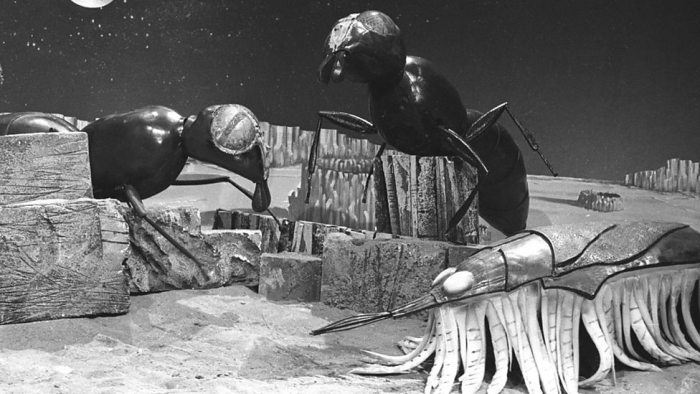The Mechanoid takes the time-travellers up to the city. The lift they travel in is incredibly quiet, which is either an intentional touch (to suggest how advanced the Mechanoids are) or it’s because Richard Martin forgot to add any sound effects. Given all that’s happened so far, I tend to favour the latter possibility ….
It’s easy to see where a large part of the budget went. The Mechanoids are substantial creations, although their sheer size and unwieldiness was a major factor in making this their only appearance.
The episode has a faint echo of The Daleks – the Doctor and his friends are apprehended by the strange inhabitants of a futuristic city who then imprison them – but the Mechanoids have quite different motives from the Daleks.
The Daleks are thinking creatures, acting on fear and racial hatred, whilst the Mechanoids are purely machines – they aren’t evil, they’re simply obeying their programming. And if that means keeping people captive (albeit in comfortable surroundings) then so be it.
Steven Taylor (Peter Purves) has been a prisoner of the Mechanoids for several years. Starved of any human contact during that time, his first reaction when he meets the Doctor and his friends is to wonder if they’re real.
This might suggest that his grip on reality has started to go, but we’ll soon see that he’s still a very resourceful young man. After appearing as the hillbilly Morton Dill a few episodes earlier, Purves (now with a natty beard) returned to play a quite different character.
With the imminent departure of William Russell and Jacqueline Hill, Purves would go on to be the solid rock of the series during the next year or so. William Hartnell remained the star (although there are points during series three, which we’ll no doubt touch upon in due course, where he’s rather sidelined) but his increasing health issues meant that he would come to depend on Purves, who would be invaluable in dealing with his variable moods.
One interesting point is that the Daleks refer to the Mechanoids as Mechons, due to the fact that all their dialogue was pre-recorded before this script element was changed. Given the chaotic nature of the story it’s good there aren’t any glaringly obvious Dalek dialogue mis-cues (as happened in The Dalek Invasion of Earth).
The set-piece battle between the Daleks and the Mechanoids is impressive – an element of the serial which benefitted from being shot on film. It’s got nothing to do with the Doctor though, who’s hot-footing it with the others down to the surface of the planet, courtesy of a very long rope. Possibly Terry Nation already had visions of his big-budget Dalek series (in which they maybe faced off against the Mechanoids week after week) so was this ending something of a trial run?
So that just leaves the departure of Ian and Barbara. Companion exits tend to happen in one of two ways – either their desire to leave is hinted throughout their final story (Susan or Victoria, for example) or, like Ian and Barbara, they only decide at the end of the story that the time is right to go.
The discovery of the Daleks’ abandoned time machine gives them a perfect opportunity to return to their own time (remember this was still the period when the Doctor had no control over the TARDIS) although the Doctor’s very dubious.
You’ve got to a feel a little for Hartnell here. Although the Doctor’s obviously sorry to have to say goodbye to Ian and Barbara, William Hartnell was even more unhappy that William Russell and Jacqueline Hill were leaving. Possibly this contributes to one of his most famous fluffs (he tells them they’ll end up as cinders floating around in “spain, err space”) if they use the DARDIS.
I love the photo-montage that shows their delight in returning to the 1960’s, especially Ian’s mock-horror at observing a telephone box! They’ll certainly both be missed, as Ian and Barbara were the moral centre of the series (especially during the early stories) but it’s true that their place in the series was becoming slightly redundant.
By this point the Doctor was a much more rounded character, so he didn’t need other people to act as his conscience. All he needed was a young girl to get into scrapes and a young man to provide a bit of muscle – a formula that would endure for the rest of the decade.




















